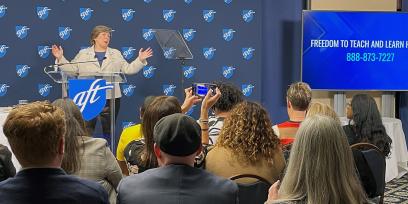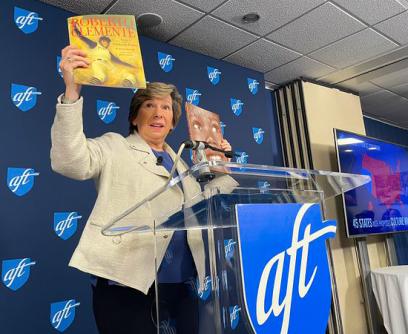The threats against public education are dire, and in a major address March 28, AFT President Randi Weingarten was frank as she enumerated them. Yet, her leading message was one of hope. Weingarten not only described the shimmering promise and purpose of public education, she also laid out a clear and powerful pathway to realize its potential and overcome learning loss with four specific strategies: community schools; experiential learning; addressing teacher and staff shortages; and ensuring genuine partnerships among parents, families and educators.
Those partnerships were underscored by guests at the address: parents and teachers from Houston who spoke briefly about working together against a state takeover of their schools, and who have united to “say yes to funding and no to politics,” as teacher Traci Latson said. “I want to ensure my community doesn’t continue to get the short end of the stick,” said parent activist Kourtney Revels. Also on hand, to introduce Weingarten, was Tamara Simpson, a former Weingarten student who has been a teacher for 23 years in the same Brooklyn neighborhood where she grew up.
Public schools are not perfect, Weingarten began, but we are committed to making them the best they can be—and to ensuring they continue to reliably offer all students the opportunity to prepare for life, college, career and citizenship. Public schools “are the manifestation of our civic values and ideals,” she said, a crucial foundation to create understanding among people with different beliefs and backgrounds, and the manifestation of the belief that goes back to this country’s founders: that “an educated citizenry is essential to protect our democracy from demagogues.”
But so many bad actors are working to undermine that foundation.
Spreading distrust
People like former President Donald Trump ally Steve Bannon and Gov. Ron DeSantis’ appointee and culture war orchestrator Christopher Rufo are open about their intent, said Weingarten, who described their methods this way: “Starve public schools of the funds they need to succeed. Criticize them for their shortcomings. Erode trust in public schools by stoking fear and division, including attempting to pit parents against teachers. And replace them with private, religious, online and home schools. All toward their end goal of destroying public education as we know it, atomizing and balkanizing education in America, bullying the most vulnerable amongst us and leaving the students with the greatest needs in public schools with the most meager resources.”
The effort is funded by deep-pocketed billionaires and corporate interests and perpetuated by legislation that creates or expands existing voucher programs—which allow parents to take money intended for public schools and use it for private school tuition or home schooling. At present, 29 state legislatures are considering pro-voucher programs, and 72 more are already subsidizing non-public schools in 33 states at a cost of billions of dollars every year. Yet “research shows that, on average, vouchers negatively affect achievement,” said Weingarten. “In fact, vouchers have caused some of the largest academic drops ever measured in the research record.”
Another weapon against public schools is the ongoing culture war. What began as a fight over pandemic-era safety measures, said Weingarten, “has morphed into fearmongering,” with false claims about teaching children critical race theory, unfounded accusations that teachers are “grooming and indoctrinating” students and “pronouncements that public schools push a ‘woke’ agenda.” Book bans and bullying are on the rise, and school board meetings are “descending into screaming matches.”
For three years, legislation designed to restrict teaching about race, gender, LGBTQIA+ issues, current events and American history has been flourishing; some districts are banning biographies of heroes like Ruby Bridges, Anne Frank and Roberto Clemente, and others are passing laws that attack transgender children. “Students and staff should feel welcome, safe and respected in school—but the culture wars are fueling hostility and fear,” said Weingarten. In Florida, teachers and librarians worry over felony prosecution for providing books that may be deemed inappropriate at a future date; and colleges and universities are pulling diversity, equity and inclusion programming for fear of lawsuits, creating a “climate of fear and intimidation.”
Compounding matters, legislators are targeting unions, trying to weaken educators’ voices as they fight to teach their students in the most complete and inclusive way possible, without censorship or threats to their academic freedom—and their livelihoods.
“These attacks aren’t about protecting kids,” said Weingarten. “If they were, these same governors would be working with us to address learning loss and the youth mental health crisis.” They would work against gun violence, she said, an issue that was on everyone’s minds the day of Weingarten’s speech, just one day following a school shooting in Nashville that left seven people dead. And they would take on social media companies that contribute to the mental health crisis.
“It’s literally a matter of life and death,” said Weingarten. Forty-five percent of LGBTQIA+ youth seriously considered attempting suicide in the last year. The number of Black youth who die by suicide is growing. Schools are understaffed, and educators are stressed by the same issues students face, plus attacks on teachers, inadequate pay and poor learning conditions. “Even before the pandemic, nearly 300,000 teachers were leaving the profession each year,” said Weingarten. “Now, based upon our estimates and other estimates, it’s closer to 400,000.”
A pathway forward
Despite these steep challenges, public schools can still be safe and welcoming places, said Weingarten, who outlined four strategies for good outcomes. She laid out these key solutions as the best ways to help public education address the needs of all students and overcome learning loss:
- Strengthen and expand community schools;
- Re-engage students with experiential learning;
- Revive and restore the teaching profession to address school staff shortages; and
- Deepen partnerships with parents and the community.
These strategies—not vouchers, not political rhetoric—will help parents and teachers effectively address the social, emotional and academic needs of students; and they are crucial in addressing the challenges students face with learning loss, trauma and anxiety.
Community schools
Community schools—which reach out in multiple ways beyond academics—can be lifesavers. “School connectedness, defined as feeling close to people at school, has a long-lasting, protective impact for adolescents well into adulthood,” said Weingarten, quoting from a University of Calgary study of suicide among young people. She described AFT-supported community schools with access to medical checkups, clothing and mental health services that serve people living in poverty, and engaging after-school programming in robotics, soccer, orchestra, Mexican dance and other activities that keep families involved.
“AFT members have helped create 700 community schools across the country, and we see how they meet kids’ needs,” said Weingarten. “That’s why we are calling for 25,000 community schools by 2025.”
Experiential learning
Experiential learning is another key way to engage students with “problem-solving, critical thinking, teamwork and learning by doing,” said Weingarten. Activities like robotics and debate are the kind of learning that “nurtures kids’ natural curiosity and creativity,” and should be “the norm, not the exception.” Capstone projects, service-learning and community-based activities ground this approach, which is deeply embedded in career and technical education.
The proof of success is in the numbers: 94 percent of young people who concentrate in CTE graduate from high school, and 72 percent of them go to college, said Weingarten. Subjects can range from auto repair to nursing, IT to graphic design, welding to hospitality, but all the skills CTE students gain give them a head start when they go to college or start their careers. Weingarten cited the Harbor School in New York City, where students learn marine science and oceanography, as well as the Teaching and Reaching initiative in Louisiana, where students earn credits to pursue a degree in education after high school. Others plug in to green energy jobs or automotive technology.
Weingarten called for more employers to partner with educators and offer paid internships and apprenticeships so students can afford to participate, and she noted that the AFT has provided stipends for Newark, N.J., high schoolers enrolled in the Red Hawk teacher pathway program.
Staff shortages
“We need to revive the teaching profession,” said Weingarten. “We have to address the teacher and school staff shortage crisis. And we have to take care of the educators we still have.” Teacher pay is a good place to start, and she cited partnerships with New Mexico Gov. Michelle Lujan Grisham, who raised salaries by $10,000, and Michigan Gov. Gretchen Whitmer, whose education budget is the highest in her state’s history, with money for school infrastructure, teacher recruitment, school safety and mental health resources. Proposed federal legislation to raise teacher salaries could also help solve the staffing crisis.
Retaining current teachers is crucial, too, and Weingarten ticked off ways to accomplish this: treat educators like professionals; provide pay and time to prepare for classes, collaborate with colleagues and undertake meaningful professional development; and give them the authority to make day-to-day classroom decisions.
Partnering with the community
At a time when public school opponents are driving a wedge through school-family and teacher-parent connections, Weingarten said we need to deepen those connections, working together for the good of the children and the community. “PTAs are remarkable organizations; so are the many parent groups and parent-teacher groups like Red Wine and Blue, ParentsTogether, MomsRising and the Campaign for Our Shared Future,” she said, noting that the AFT is “honored” to work with them.
The union has also created the Powerful Partnerships Institute, supporting family and community engagement projects across the nation with grants to AFT locals working closely with community partners. Even when we disagree on how to reach the best solutions for our schools, the union has modeled ways to deal with conflict, said Weingarten, bringing together parent groups that disagreed with the union on COVID-19 safety measures and school closures. “We heard each other out, we talked things through,” said Weingarten. “We need more of that in America.”
“This can’t just be the work of our union or of school staff or of schools alone,” she said. “This is the work of a great nation—to ensure that our children’s basic human needs are met so they’re ready to learn to their full potential. To exchange outmoded and test-driven ways of teaching and learning for effective and engaging approaches that excite students and prepare them to live their dreams and aspirations.
“We are at a crossroads: Fear and division, or hope and opportunity,” Weingarten concluded. “A great nation does not fear people being educated. A great nation does not fear pluralism. A great nation doesn’t have a gun epidemic problem. A great nation chooses freedom, democracy, equality and opportunity. All of that starts in our public schools. We, the United States of America, we are that great nation, and we must act together—to defend, support and strengthen our public schools. And we must do that now. Our children deserve no less.”



